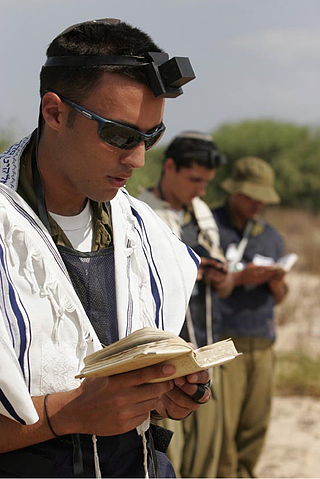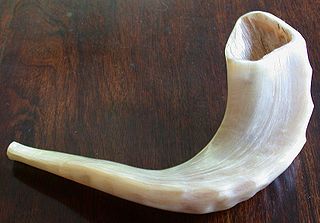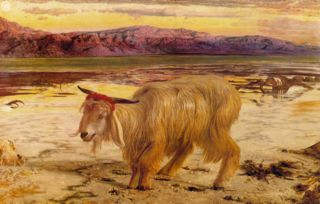
Jewish holidays, also known as Jewish festivals or Yamim Tovim, are holidays observed in Judaism and by Jews throughout the Hebrew calendar. They include religious, cultural and national elements, derived from three sources: biblical mitzvot ("commandments"), rabbinic mandates, and the history of Judaism and the State of Israel.

Jewish prayer is the prayer recitation that forms part of the observance of Rabbinic Judaism. These prayers, often with instructions and commentary, are found in the Siddur, the traditional Jewish prayer book.

Yom Kippur is the holiest day in Judaism and Samaritanism. It occurs annually on the 10th of Tishrei, the first month of the Hebrew calendar. Primarily centered on atonement and repentance, the day's observances consist of full fasting and ascetic behavior accompanied by intensive prayer as well as sin confessions. Alongside the related holiday of Rosh HaShanah, Yom Kippur is one of the two components of the "High Holy Days" of Judaism.
Jules Harlow is a Conservative Jewish rabbi and liturgist; son of Henry and Lena Lipman Harlow. He was born in Sioux City, Iowa.

Kiddush, literally, "sanctification", is a blessing recited over wine or grape juice to sanctify the Shabbat and Jewish holidays. Additionally, the word refers to a small repast held on Shabbat or festival mornings after the prayer services and before the meal.

The High Holidays also known as the High Holy Days, or Days of Awe in Judaism, more properly known as the Yamim Noraim
- strictly, the holidays of Rosh HaShanah and Yom Kippur ;
- by extension, the period of ten days including those holidays, known also as the Ten Days of Repentance ; or,
- by a further extension, the entire 40-day penitential period in the Jewish year from Rosh Chodesh Elul to Yom Kippur, traditionally taken to represent the forty days Moses spent on Mount Sinai before coming down with the second ("replacement") set of the Tablets of Stone.

Jewish writers in England during the pre-expulsion period of the eleventh through the thirteenth centuries produced different kinds of writing in Hebrew. Many were Tosafists; others wrote legal material, and some wrote liturgical poetry and literary texts.
It is believed that the first Jews in England arrived during the Norman Conquest of the country by William the Conqueror in 1066. The first written record of Jewish settlement in England dates from 1070. They suffered massacres in 1189–90. In 1290, all Jews were expelled from England by the Edict of Expulsion.
Yom Tov ben Abraham of Seville commonly known by the Hebrew acronym Ritva, was a medieval rabbi and rosh yeshiva of the Yeshiva of Seville, known for his commentaries on the Talmud.

Rabbi Gershon Shaul Yom-Tov Lipmann ben Nathan ha-Levi Heller, was a Bohemian rabbi and Talmudist, best known for writing a commentary on the Mishnah called the Tosefet Yom-Tov (1614–1617). Heller was one of the major Talmudic scholars in Prague and in Poland during the "Golden Age" before 1648.
Mussaf is an additional service that is recited on Shabbat, Yom Tov, Chol Hamoed, and Rosh Chodesh. The service, which is traditionally combined with the Shacharit in synagogues, is considered to be additional to the regular services of Shacharit, Mincha, and Maariv. In contemporary Hebrew, the word may also signify a newspaper supplement.

Acharei Mot is the 29th weekly Torah portion in the annual Jewish cycle of Torah reading. It is the sixth weekly portion in the Book of Leviticus, containing Leviticus 16:1–18:30. It is named after the fifth and sixth Hebrew words of the parashah, its first distinctive words.
Isru Chag refers to the day after each of the Three Pilgrimage Festivals in Judaism: Pesach, Shavuot and Sukkot.
Sabbath mode, also known as Shabbos mode or Shabbat mode, is a feature in many modern home appliances, including ovens, dishwashers, and refrigerators, which is intended to allow the appliances to be used by Shabbat-observant Jews on the Shabbat and Jewish holidays. The mode usually overrides the usual, everyday operation of the electrical appliance and makes the operation of the appliance comply with the rules of Halakha.
This timeline of antisemitism chronicles events in the history of antisemitism, hostile actions or discrimination against Jews as members of a religious and/or ethnic group. It includes events in Jewish history and the history of antisemitic thought, actions which were undertaken in order to counter antisemitism or alleviate its effects, and events that affected the prevalence of antisemitism in later years. The history of antisemitism can be traced from ancient times to the present day.
Siget or Ujhel-Siget or Sighet Hasidism, or Sigter Hasidim, is a movement of Hungarian Haredi Jews who adhere to Hasidism, and who are referred to as Sigeter Hasidim.
Josce of York was the leader of the Jewish community in York, England, and the leading figure in the York pogrom of 1190. He committed suicide along with nearly the entire Jewish community, rather than face death or conversion at the hands of an angry mob.
Pesukei dezimra, or zemirot as they are called in the Spanish and Portuguese tradition, are a group of prayers that may be recited during Shacharit. They consist of various blessings, psalms, and sequences of other Biblical verses. Historically, reciting pesukei dezimra in morning prayer was a practice of only the especially pious. Over the course of Jewish history, their recitation has become widespread custom among all of the various rites of Jewish prayer.
Martyrdom in Judaism is one of the main examples of Jews doing a kiddush Hashem, a Hebrew term which means "sanctification of [the] name". An example of this is public self-sacrifice in accordance with Jewish practice and identity, with the possibility of being killed for no other reason than being Jewish. There are specific conditions in Jewish law that deal with the details of self-sacrifice, be it willing or unwilling.
Newbo Abbey was a Premonstratensian house of canons regular in Lincolnshire, England, dedicated to the Assumption of Mary.








